Open Innovation Strategies and Implementation at Siemens Report
VerifiedAdded on 2021/04/16
|7
|950
|95
Report
AI Summary
This report provides a critical review of open innovation at Siemens, beginning with a definition of the concept and its importance. It explores Siemens' adoption of open innovation, highlighting the shift from a decentralized structure and the challenges it aimed to solve, such as silo mentality and poor communication. The report details various open innovation programs implemented by Siemens, including idea generation contests like the OSRAM LED contest and discusses whether open innovation responsibilities should be centralized or decentralized. The author concludes that Siemens' success can be attributed to open innovation and recommends centralized responsibilities within business units to maximize efficiency and economies of scale. The report references several academic sources to support its claims and findings.
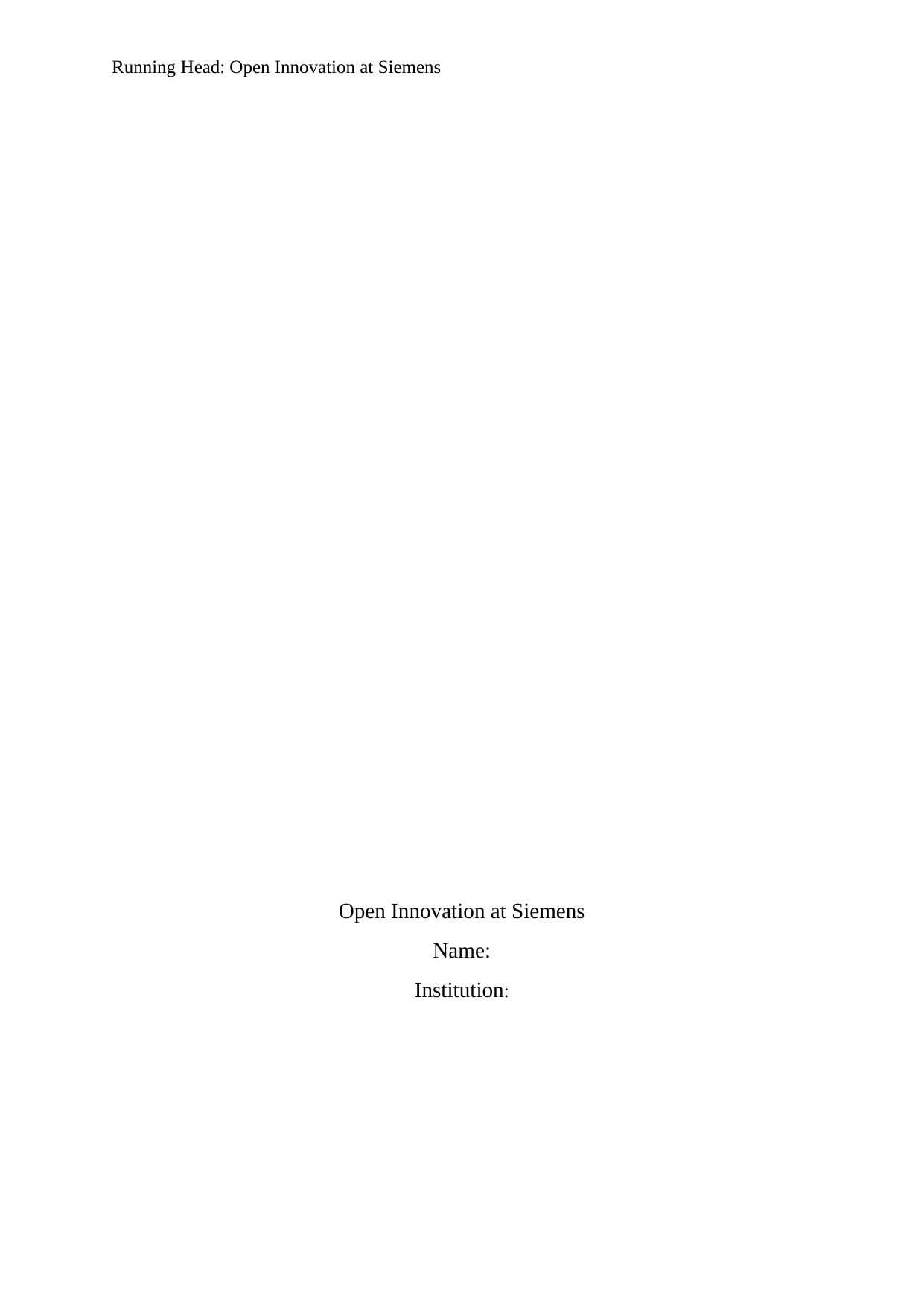
Running Head: Open Innovation at Siemens
Open Innovation at Siemens
Name:
Institution:
Open Innovation at Siemens
Name:
Institution:
Paraphrase This Document
Need a fresh take? Get an instant paraphrase of this document with our AI Paraphraser

Open Innovation at Siemens 2
Executive summary
This paper critically reviews a case study on open innovation at Siemens depictions a clear
definition of the concept. The paper further discusses the reasons that lead Siemens to adopt a
new concept in achieving its objectives Finally, the paper gives an opinion concerning
allocation of responsibilities in each business unit, should it be centralized or decentralized?
Executive summary
This paper critically reviews a case study on open innovation at Siemens depictions a clear
definition of the concept. The paper further discusses the reasons that lead Siemens to adopt a
new concept in achieving its objectives Finally, the paper gives an opinion concerning
allocation of responsibilities in each business unit, should it be centralized or decentralized?
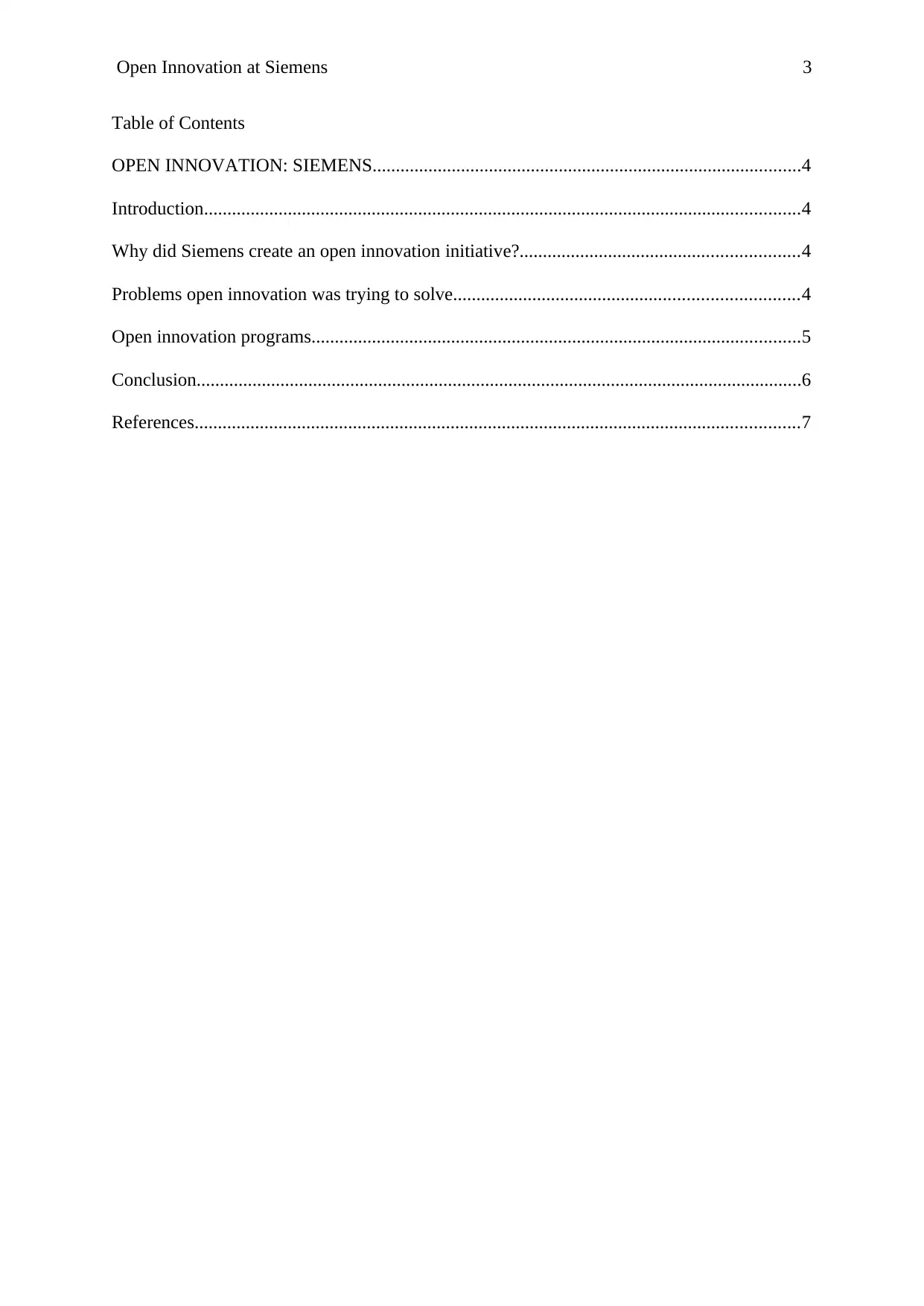
Open Innovation at Siemens 3
Table of Contents
OPEN INNOVATION: SIEMENS............................................................................................4
Introduction................................................................................................................................4
Why did Siemens create an open innovation initiative?............................................................4
Problems open innovation was trying to solve..........................................................................4
Open innovation programs.........................................................................................................5
Conclusion..................................................................................................................................6
References..................................................................................................................................7
Table of Contents
OPEN INNOVATION: SIEMENS............................................................................................4
Introduction................................................................................................................................4
Why did Siemens create an open innovation initiative?............................................................4
Problems open innovation was trying to solve..........................................................................4
Open innovation programs.........................................................................................................5
Conclusion..................................................................................................................................6
References..................................................................................................................................7
⊘ This is a preview!⊘
Do you want full access?
Subscribe today to unlock all pages.

Trusted by 1+ million students worldwide
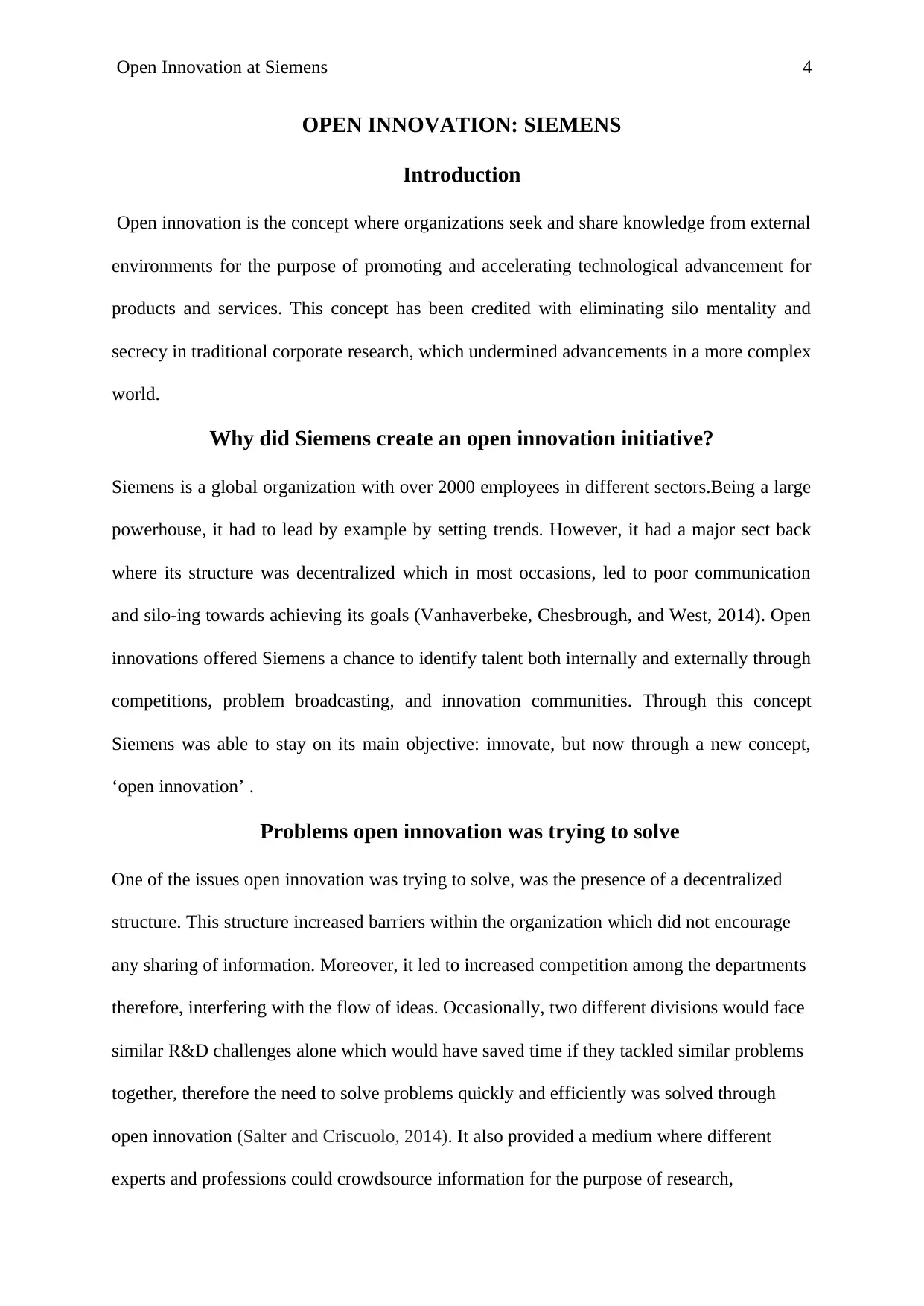
Open Innovation at Siemens 4
OPEN INNOVATION: SIEMENS
Introduction
Open innovation is the concept where organizations seek and share knowledge from external
environments for the purpose of promoting and accelerating technological advancement for
products and services. This concept has been credited with eliminating silo mentality and
secrecy in traditional corporate research, which undermined advancements in a more complex
world.
Why did Siemens create an open innovation initiative?
Siemens is a global organization with over 2000 employees in different sectors.Being a large
powerhouse, it had to lead by example by setting trends. However, it had a major sect back
where its structure was decentralized which in most occasions, led to poor communication
and silo-ing towards achieving its goals (Vanhaverbeke, Chesbrough, and West, 2014). Open
innovations offered Siemens a chance to identify talent both internally and externally through
competitions, problem broadcasting, and innovation communities. Through this concept
Siemens was able to stay on its main objective: innovate, but now through a new concept,
‘open innovation’ .
Problems open innovation was trying to solve
One of the issues open innovation was trying to solve, was the presence of a decentralized
structure. This structure increased barriers within the organization which did not encourage
any sharing of information. Moreover, it led to increased competition among the departments
therefore, interfering with the flow of ideas. Occasionally, two different divisions would face
similar R&D challenges alone which would have saved time if they tackled similar problems
together, therefore the need to solve problems quickly and efficiently was solved through
open innovation (Salter and Criscuolo, 2014). It also provided a medium where different
experts and professions could crowdsource information for the purpose of research,
OPEN INNOVATION: SIEMENS
Introduction
Open innovation is the concept where organizations seek and share knowledge from external
environments for the purpose of promoting and accelerating technological advancement for
products and services. This concept has been credited with eliminating silo mentality and
secrecy in traditional corporate research, which undermined advancements in a more complex
world.
Why did Siemens create an open innovation initiative?
Siemens is a global organization with over 2000 employees in different sectors.Being a large
powerhouse, it had to lead by example by setting trends. However, it had a major sect back
where its structure was decentralized which in most occasions, led to poor communication
and silo-ing towards achieving its goals (Vanhaverbeke, Chesbrough, and West, 2014). Open
innovations offered Siemens a chance to identify talent both internally and externally through
competitions, problem broadcasting, and innovation communities. Through this concept
Siemens was able to stay on its main objective: innovate, but now through a new concept,
‘open innovation’ .
Problems open innovation was trying to solve
One of the issues open innovation was trying to solve, was the presence of a decentralized
structure. This structure increased barriers within the organization which did not encourage
any sharing of information. Moreover, it led to increased competition among the departments
therefore, interfering with the flow of ideas. Occasionally, two different divisions would face
similar R&D challenges alone which would have saved time if they tackled similar problems
together, therefore the need to solve problems quickly and efficiently was solved through
open innovation (Salter and Criscuolo, 2014). It also provided a medium where different
experts and professions could crowdsource information for the purpose of research,
Paraphrase This Document
Need a fresh take? Get an instant paraphrase of this document with our AI Paraphraser
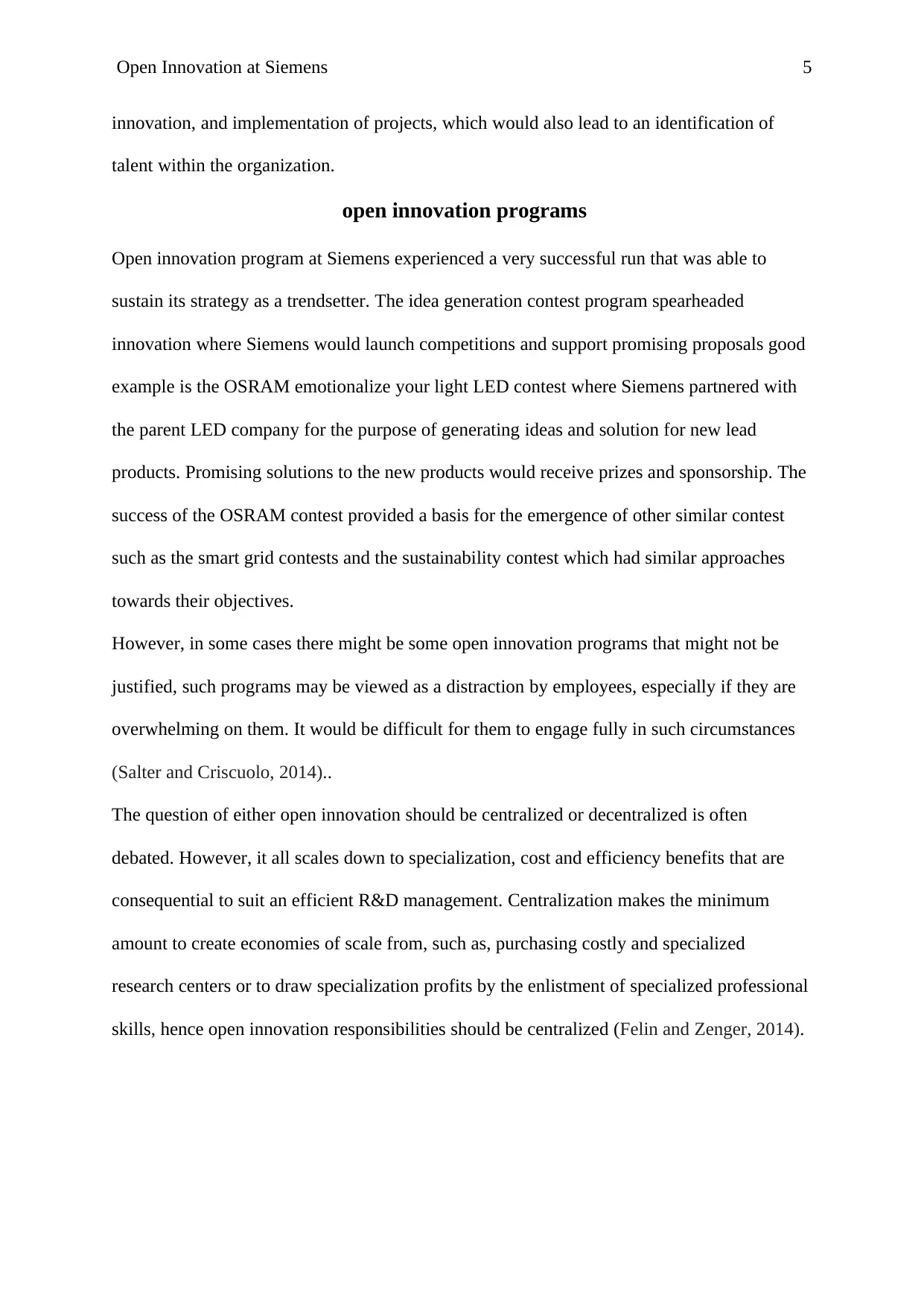
Open Innovation at Siemens 5
innovation, and implementation of projects, which would also lead to an identification of
talent within the organization.
open innovation programs
Open innovation program at Siemens experienced a very successful run that was able to
sustain its strategy as a trendsetter. The idea generation contest program spearheaded
innovation where Siemens would launch competitions and support promising proposals good
example is the OSRAM emotionalize your light LED contest where Siemens partnered with
the parent LED company for the purpose of generating ideas and solution for new lead
products. Promising solutions to the new products would receive prizes and sponsorship. The
success of the OSRAM contest provided a basis for the emergence of other similar contest
such as the smart grid contests and the sustainability contest which had similar approaches
towards their objectives.
However, in some cases there might be some open innovation programs that might not be
justified, such programs may be viewed as a distraction by employees, especially if they are
overwhelming on them. It would be difficult for them to engage fully in such circumstances
(Salter and Criscuolo, 2014)..
The question of either open innovation should be centralized or decentralized is often
debated. However, it all scales down to specialization, cost and efficiency benefits that are
consequential to suit an efficient R&D management. Centralization makes the minimum
amount to create economies of scale from, such as, purchasing costly and specialized
research centers or to draw specialization profits by the enlistment of specialized professional
skills, hence open innovation responsibilities should be centralized (Felin and Zenger, 2014).
innovation, and implementation of projects, which would also lead to an identification of
talent within the organization.
open innovation programs
Open innovation program at Siemens experienced a very successful run that was able to
sustain its strategy as a trendsetter. The idea generation contest program spearheaded
innovation where Siemens would launch competitions and support promising proposals good
example is the OSRAM emotionalize your light LED contest where Siemens partnered with
the parent LED company for the purpose of generating ideas and solution for new lead
products. Promising solutions to the new products would receive prizes and sponsorship. The
success of the OSRAM contest provided a basis for the emergence of other similar contest
such as the smart grid contests and the sustainability contest which had similar approaches
towards their objectives.
However, in some cases there might be some open innovation programs that might not be
justified, such programs may be viewed as a distraction by employees, especially if they are
overwhelming on them. It would be difficult for them to engage fully in such circumstances
(Salter and Criscuolo, 2014)..
The question of either open innovation should be centralized or decentralized is often
debated. However, it all scales down to specialization, cost and efficiency benefits that are
consequential to suit an efficient R&D management. Centralization makes the minimum
amount to create economies of scale from, such as, purchasing costly and specialized
research centers or to draw specialization profits by the enlistment of specialized professional
skills, hence open innovation responsibilities should be centralized (Felin and Zenger, 2014).
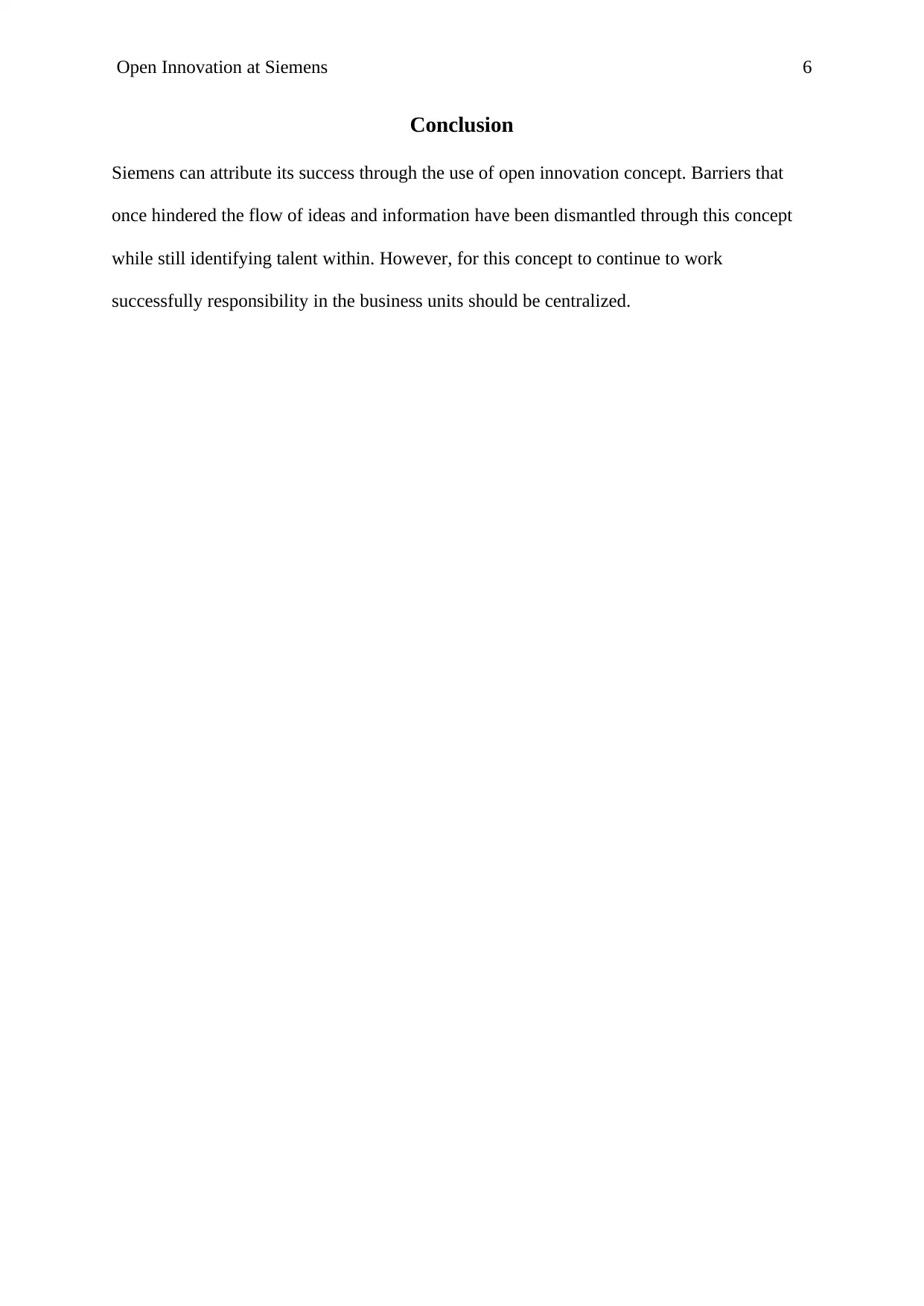
Open Innovation at Siemens 6
Conclusion
Siemens can attribute its success through the use of open innovation concept. Barriers that
once hindered the flow of ideas and information have been dismantled through this concept
while still identifying talent within. However, for this concept to continue to work
successfully responsibility in the business units should be centralized.
Conclusion
Siemens can attribute its success through the use of open innovation concept. Barriers that
once hindered the flow of ideas and information have been dismantled through this concept
while still identifying talent within. However, for this concept to continue to work
successfully responsibility in the business units should be centralized.
⊘ This is a preview!⊘
Do you want full access?
Subscribe today to unlock all pages.

Trusted by 1+ million students worldwide
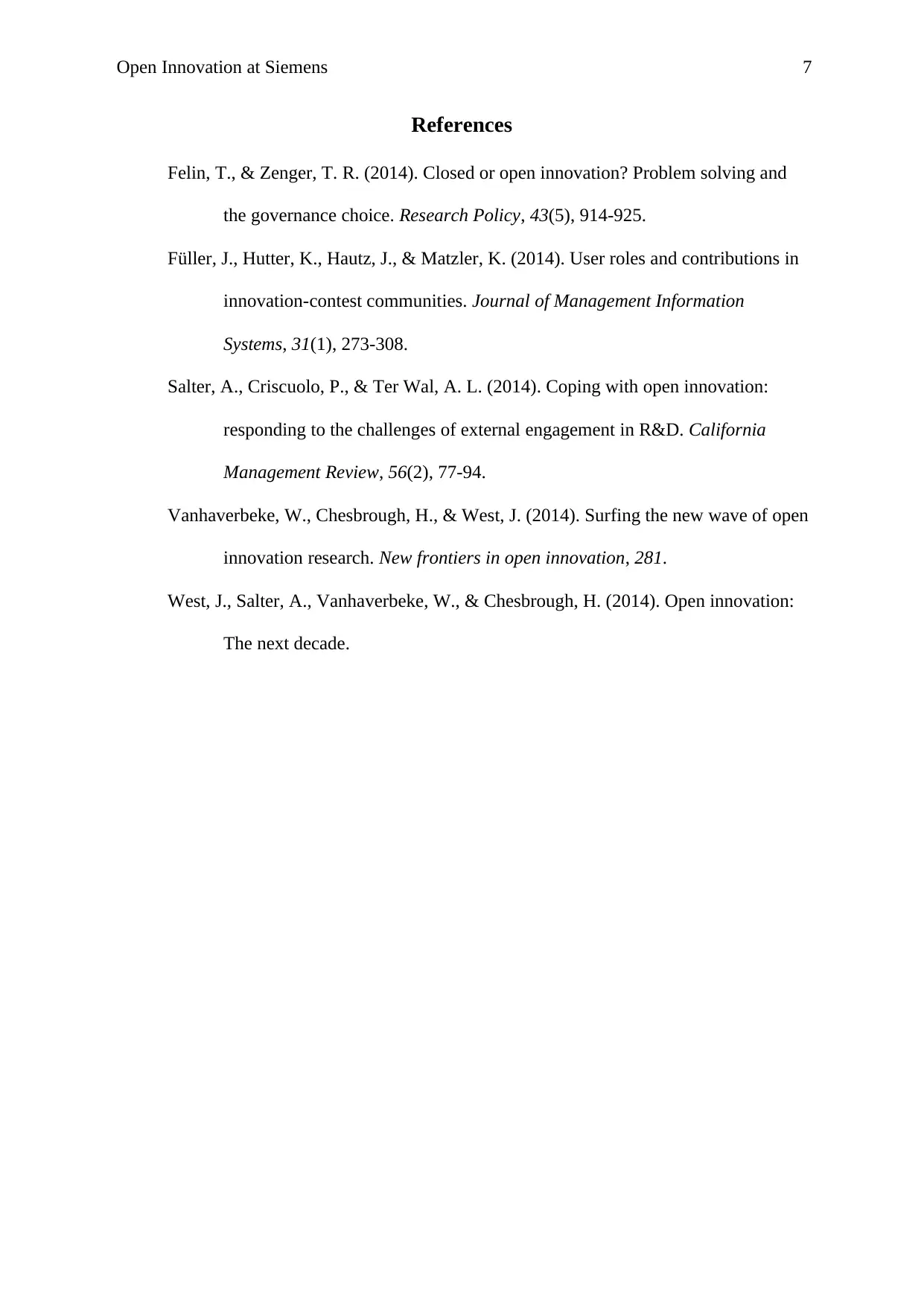
Open Innovation at Siemens 7
References
Felin, T., & Zenger, T. R. (2014). Closed or open innovation? Problem solving and
the governance choice. Research Policy, 43(5), 914-925.
Füller, J., Hutter, K., Hautz, J., & Matzler, K. (2014). User roles and contributions in
innovation-contest communities. Journal of Management Information
Systems, 31(1), 273-308.
Salter, A., Criscuolo, P., & Ter Wal, A. L. (2014). Coping with open innovation:
responding to the challenges of external engagement in R&D. California
Management Review, 56(2), 77-94.
Vanhaverbeke, W., Chesbrough, H., & West, J. (2014). Surfing the new wave of open
innovation research. New frontiers in open innovation, 281.
West, J., Salter, A., Vanhaverbeke, W., & Chesbrough, H. (2014). Open innovation:
The next decade.
References
Felin, T., & Zenger, T. R. (2014). Closed or open innovation? Problem solving and
the governance choice. Research Policy, 43(5), 914-925.
Füller, J., Hutter, K., Hautz, J., & Matzler, K. (2014). User roles and contributions in
innovation-contest communities. Journal of Management Information
Systems, 31(1), 273-308.
Salter, A., Criscuolo, P., & Ter Wal, A. L. (2014). Coping with open innovation:
responding to the challenges of external engagement in R&D. California
Management Review, 56(2), 77-94.
Vanhaverbeke, W., Chesbrough, H., & West, J. (2014). Surfing the new wave of open
innovation research. New frontiers in open innovation, 281.
West, J., Salter, A., Vanhaverbeke, W., & Chesbrough, H. (2014). Open innovation:
The next decade.
1 out of 7
Related Documents
Your All-in-One AI-Powered Toolkit for Academic Success.
+13062052269
info@desklib.com
Available 24*7 on WhatsApp / Email
![[object Object]](/_next/static/media/star-bottom.7253800d.svg)
Unlock your academic potential
Copyright © 2020–2025 A2Z Services. All Rights Reserved. Developed and managed by ZUCOL.





